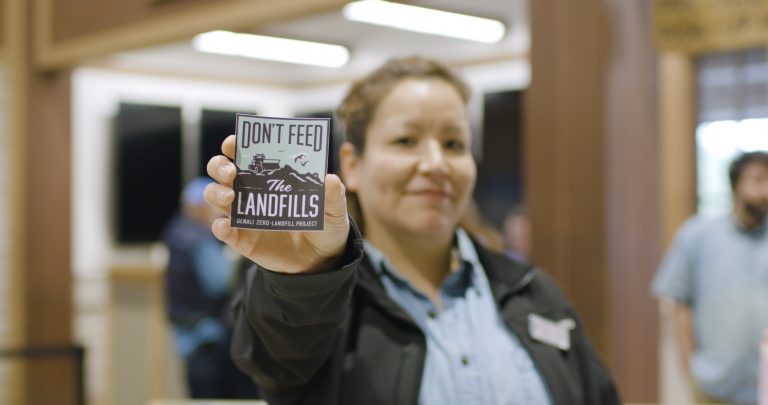Alaska is the 14th state my husband and I have lived in, and one of the things that sticks with us the most is how each state—let alone municipality—handles recycling. We’ve seen a gamut—from organized source-separated recycling/composting to single-stream mixed recycling to no recycling.
Recycling, composting, and other zero waste practices present lofty goals anywhere, but when we made Healy our home in 2019, we quickly realized that Alaska trumps everywhere else in complexity because of logistics and the way things move in, out, and around the state.
Where does a disposable plastic bottle end up when you toss it into a trash bin? If you’re visiting our backyard, Denali National Park and Preserve, it travels more than 200 miles south to a landfill in Palmer and then sits there…forever. Plastic breaks apart and turns into microplastics, but it never goes away completely.
What if you threw that same bottle into a recycling bin—the better choice—in Denali? It’s still transported more than 200 miles south to Valley Community Recycling Solutions, a full-scale materials recycling center in Palmer. Then those materials ship 2,000 miles or more to processing facilities outside of Alaska, where they’re recycled into something useful.
Denali National Park, the surrounding community, and concessionaries have been on a mission toward more zero landfill practices since 2015. And it’s working.
Starting the change
Subaru of America sparked Denali’s zero landfill goals. In 2004, the Subaru plant in Indiana became the first and only car manufacturer to become zero landfill, meaning they create no trash by reusing packaging, reducing parts and materials, and recycling/composting. Subaru thought if they could achieve it, the model could work for others, like national parks. So, in partnership with the National Park Service and the National Parks Conservation Association, the Zero Landfill Initiative and #dontfeedthelandfills campaign was born and included three pilot national parks: Denali, Grand Teton, and Yosemite.
The objective was to find ways for staff and systems to operate more sustainably—by reducing, reusing, and recycling—which could divert more trash from the local landfills. While Denali National Park disposed of 15 tons of trash in the Denali Borough Landfill in 1995, that figure had grown to 220 tons by 2015. In a popular national park that sees more than 600,000 visitors annually, trash was sure to keep growing.

With the help of funding and expertise, the park service made many changes, including upgrading its water refilling stations and recycling program. There are now 35 bear-proof triple-bin recycling containers throughout Denali with standardized labels from Recycle Across America. The park recycles clean and empty plastic bottles (#1, #2, and #5), aluminum cans, tin cans, glass, mixed paper, cardboard, and more. National Park Service maintenance workers used to handle the recycling, but in October 2018, the park hired their first year-round dedicated recycle manager, Linda Dingbaum.
“I love my job,” Dingbaum said. “There’s been so much change since I started. It’s way more streamlined, there’s a lot less contamination, and we’re recycling more!”
Recycling outside Denali
Beyond park boundaries, zero landfill efforts extend through the entire Denali Borough and various park concessionaires. Denali Education Center, a nonprofit in nearby McKinley Village, wanted to get involved from the start.
“It has been incredible to see the community’s involvement grow since its inception in 2015,” said Jodi Rodwell, the center’s executive director. “Business and community leaders have stepped up to the plate and real change is happening.”
The borough’s Tri-Valley School started the Zero Landfill Ambassador Program, with more than 35 students getting involved over the years through cleanups and other zero waste initiatives.
“Getting kids involved helped plant the seed that the initiative was something to pay attention to,” said Rodwell.
Concessionaire Doyon/Aramark Joint Venture, which operates the bus tours, campgrounds, and Morino Grill inside the park, created its own waves. Not only do they manage their own recycling center, they also ensure that all items in the “Tundra Wilderness Tour” boxed lunch are either compostable or recyclable, even the chip bag wrappers through a special partnership with Terracycle, a New Jersey-based firm that specializes in hard-to-recycle materials. Several other businesses, like Holland America and Princess Cruises, which typically bring two-thirds of the visitors to Denali, have recycling efforts in motion as well.
The nearby village of Cantwell received a grant and started its own year-round community recycling program in 2015. They accept plastics (#1, #2, and #5), mixed paper, aluminum cans, tin cans, plastic grocery bags, and most recently, cardboard. As of the summer of 2021, a seasonal recycling program at the Healy Transfer Station started collecting cardboard, plastic bottles #1, and aluminum cans.
The results
The good news is everyone’s efforts are working.
Between 2014 and 2017, the amount of solid waste sent from Denali National Park to the Denali Borough Landfill decreased 37 percent. In the past, each visitor accounted for 1.6 pounds of trash/recycling, but that has decreased to less than a pound.
And as of 2019, Denali National Park was diverting 32 percent of its waste from the landfill, up from 15 percent in 2015. By 2019, Aramark was diverting packaging and food waste from more than 135,000 snack boxes. Using a wildlife-resistant food waste dumpster, Aramark tripled their compost collection to 9.5 tons
in 2019.
The only way the program will continue to grow is through more awareness.
Not only is there signage around Denali, but you might hear about the Zero Landfill Initiative even before you travel to the area thanks to magazine ads and in-room videos shown to hotel guests. There was even an episode on Growing a Greener World dedicated to Denali’s efforts. The Leave No Trace Center for Outdoor Ethics sent a team to the three Zero Landfill parks during the summers of 2018 and 2019 to help with outreach and education for employees and visitors. (That team was actually my husband and me, which is how we made Healy our forever home.)
So the next time you travel to Denali National Park—or anywhere really—think about becoming a more sustainable traveler. It takes baby steps, but if we each do our part, it adds up.


Comments are closed.